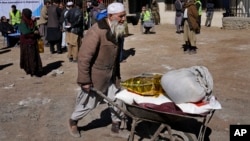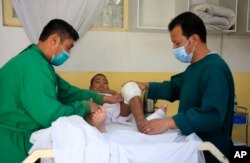There is a proverb in Afghanistan that says, “The one who feeds, commands.”
This may not be entirely true in the case of the de facto Taliban regime that rules but does not provide food for an overwhelming majority of Afghans who are suffering from hunger.
Donors and U.N. agencies, not ruling Afghans, feed them.
This year, the U.N.’s goals to spend $4.4 billion on humanitarian and essential services for Afghanistan is several times larger than the war-ravaged country’s government will spend on everything.
The Taliban government had a budget of about $520 million for the first quarter of the year.
The U.N. says together with some 150 nongovernmental organizations, it will deliver essential humanitarian assistance to some 22 million Afghans — about 70% of Afghanistan’s estimated population.
There are also funds for human rights, civil society and other non-humanitarian programs that are channeled exclusively through NGOs.
The International Committee of the Red Cross, for instance, pays the salaries of around 10,000 public health employees. An ICRC spokeswoman told VOA the organization does so in order “to prevent the health system from crumbling completely.”
To keep the country’s education system functional, the U.N. Children’s Agency has said it will pay a monthly stipend of about $100 for two months to about 194,000 public school teachers, male and female.
As Afghanistan hovered over a banking and financial crisis, the U.N. took “all conceivable measures to inject liquidity into the economy, including the physical import of cash,” Deborah Lyons, the top U.N. official for Afghanistan, told the Security Council on March 2.
The current aid approach requires U.N. agencies and NGOs to bypass the de facto government in Afghanistan because of strict international sanctions on the Taliban.
When aid agencies bypassed the local government to deliver humanitarian aid in the aftermath of a catastrophic earthquake in Haiti in 2010, some experts said donors had turned the country into a republic of NGOs.
“Arguably, Afghanistan has been an ‘NGOs republic’ for 30 to 40 years,” Rahmatullah Amiri, an independent consultant who recently co-authored a report on the Taliban’s taxation for the International Center for Tax and Development, told VOA. Since the Taliban’s ascent to power, the international aid system has gone even more unilateral, Amiri added.
No alternatives
Over the last two decades, donors spent billions of dollars on building state institutions for Afghanistan. The U.S. alone spent $36.14 billion on governance and development in Afghanistan between 2002 and 2021.
Donors have now adopted an approach that according to Florian Weigand, co-director of the Center for the Study of Armed Groups at the Overseas Development Institute, “undermines the very same institutions that the international community tried to build or strengthen.”
Before the collapse, some 75% of the government’s spending was provided by foreign donors, according to the U.S. Special Inspector General for the Reconstruction of Afghanistan.
Afghanistan’s nascent public institutions crumbled last year when the former Afghan government collapsed, and foreign donors ceased all development funds.
As public institutions failed, the country plunged into a startling economic and humanitarian crisis threatening the lives of millions of vulnerable Afghans.
“It's important to recognize that in an acute crisis when time is of the essence, providing assistance through the U.N. and NGOs can help deliver urgent lifesaving support very quickly,” Sarah Rose, a policy expert with the Center for Global Development, told VOA.
While the Afghan crisis isn’t over, Lyons told the Security Council that donors and aid agencies have averted a winter famine in Afghanistan.
Neither the Taliban government nor donors have direct oversight on international aid disbursements in Afghanistan, leaving some to worry about aid mismanagement.
"We know that U.N. agencies have high overhead costs, and they have their own fees," Nadia Akseer, a scientist at the Bloomberg School of Public Health at Johns Hopkins University, told VOA.
Taliban obligations
Already the poorest country in South Asia, Afghanistan’s GDP is set to contract about 30%, with per capital income dropping to $350 in 2022, according to the U.N. Development Program.
“We have never seen the impacts of poverty and societal breakdown on such a scale,” said Anita Dullard, an ICRC spokeswoman. “And this is only increasing.”
In an effort to raise the $4.4 billion needed to mitigate Afghanistan’s looming humanitarian crisis, this week, foreign donors will attend a joint U.N.-U.K. virtual summit.
And what does the Taliban government do to alleviate the crisis in Afghanistan?
In the words of Taliban’s chief minister Mohammad Hasan Akhund, the hunger calamity is “a test of God.” Speaking at a Cabinet meeting in November, Akhund said the Taliban were not responsible to feed the hungry masses and that people should turn to God for sustenance.
“The delivery of basic services through NGOs may look like a convenient pathway for the Taliban,” said Weigand, adding that the Taliban face the growing need to build legitimacy with the Afghan people.
Taliban leaders claim their legitimacy came from the people, but they never held elections and have abolished Afghanistan’s electoral bodies.
Taliban authorities have forcefully sought international recognition of their government, which no country has officially recognized, but they have resisted calls for the formation of an inclusive government in which women have fair representation.
The current state of affairs is not sustainable, as donors will eventually find themselves less committed to giving aid to Afghanistan indefinitely, particularly when the host government assumes no responsibility, experts say.








